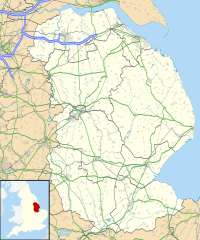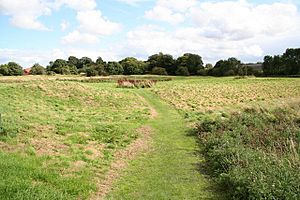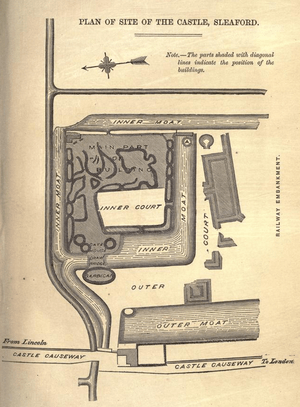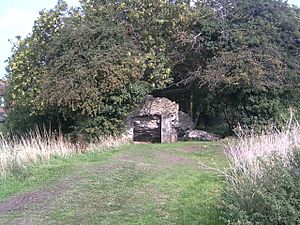Sleaford Castle facts for kids
Quick facts for kids Sleaford Castle |
|
|---|---|
| Sleaford, Lincolnshire, England | |
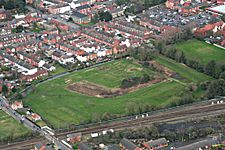
Aerial view of the castle (2020)
|
|
| Coordinates | 52°59′48″N 0°24′55″W / 52.99667°N 0.41528°W |
| Site history | |
| Materials | Stone |
Sleaford Castle was a medieval castle located in Sleaford, Lincolnshire, England. It was built by the Bishop of Lincoln in the early 1120s. The castle was used for many years, even as late as 1555. However, it started to fall apart in the second half of the 1500s. Two famous English kings stayed at the castle: King John and Henry VIII.
Contents
Building Sleaford Castle: A Bishop's Home
Sleaford Castle was built between 1123 and 1139. The person who built it was Alexander de Blois, who was the Bishop of Lincoln at that time. He was in charge from 1123 to 1147.
Bishop Alexander designed the castle with a square shape, like a rectangle. It had square towers and a very large main tower, called a keep. He chose to build it on flat, marshy land, not on a hill. This might mean there was an older house there before.
The castle was mostly used as a manor house. This means it was a large home for the bishop and his staff. It was also used to store food from the bishop's lands. It helped him manage his estates and provided a place to stay when he visited the area. It wasn't really built for fighting, even though it was hard for enemies to sneak up on it because of the flat land.
What Was Inside the Castle Walls?
For most of its history, Sleaford Castle worked as a manor house. It was never attacked in a big battle or siege. Instead, it became one of the bishop's main strongholds. It was also a central place for farming activities on the bishop's lands in Sleaford.
Inside the castle, there was a huge barn, about 40 by 15 meters. People said it was the biggest tithe barn in Lincolnshire! A tithe was like a rent paid to the bishop for using his land. People would pay by working for him, giving him a share of their crops, or paying money. This barn also had a cattle shed and a place for hay.
A dam was built across the river Slea nearby. This created a large pond with a watermill. The pond provided fresh fish for the bishop's special meals. There was also an orchard for fruit and a dovecote (a place for pigeons) for meat.
When Kings Visited Sleaford Castle
The castle almost faced a siege two times. Once, Bishop Alexander had to give his keys to King Stephen. This happened during a time of civil war called the Anarchy. Alexander did this to be set free after King Stephen captured Newark Castle. Later, in the 1320s, the bishop had to give his keys to King Edward II because the king wasn't sure if the bishop was loyal.
King John stayed at the castle for one night in October 1216. This was right after he had a terrible journey across the Wash and just before he died. In 1430, Bishop Richard Fleming also passed away at the castle.
Sleaford Castle in Later Years
King Henry VIII visited Sleaford Castle twice. One of his visits was in 1541 with his queen, Catherine Howard. He even held an important meeting, called a State Council, at the castle.
The castle later went to the Duke of Somerset in 1544. But the king took it back in 1546. Even then, and in 1555, people still said the castle was strong and livable. A writer named John Leland described it as well-kept. He mentioned it had a gatehouse with two portcullises (heavy gates that drop down) and a tall central tower.
However, Sleaford Castle started to fall apart in the second half of the 1500s. The timber and lead from its roof were taken and used to build other houses in the town. Some of these buildings still exist today! The castle continued to decline under the Carre family, who owned it next. By 1604, it was called "the late fair castle," meaning it had mostly been taken apart before 1600. An old drawing from the early 1700s shows the castle as a ruin, but with a good amount of stone still standing.
Sleaford Castle Today
Today, not much of Sleaford Castle is left. You can still see the moat (a ditch filled with water around the castle) and some earthworks (mounds and ditches in the ground). There's also a tiny piece of a wall left in one corner.
Sleaford Castle is now a scheduled monument. This means it's an important historical site protected by law. It's also a Grade II listed building. The area around the castle is now home to various wildlife.


